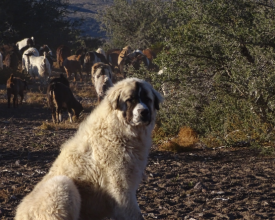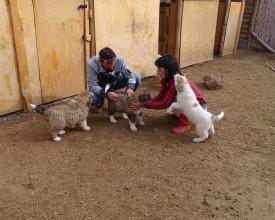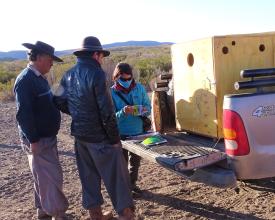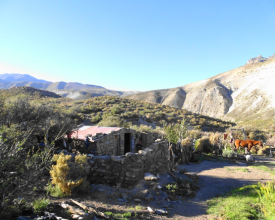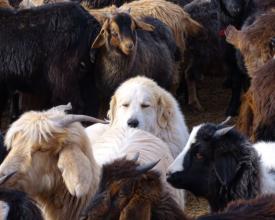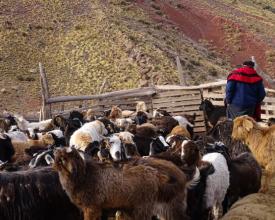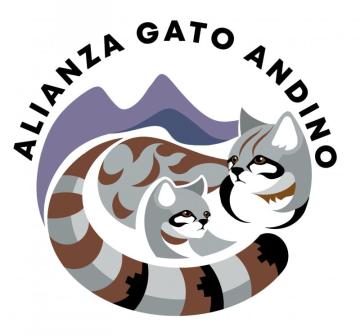
Livestock guardian dogs, a non-lethal strategy to improve coexistence between small livestock herders and wild carnivores in northern Patagonia, Argentina.
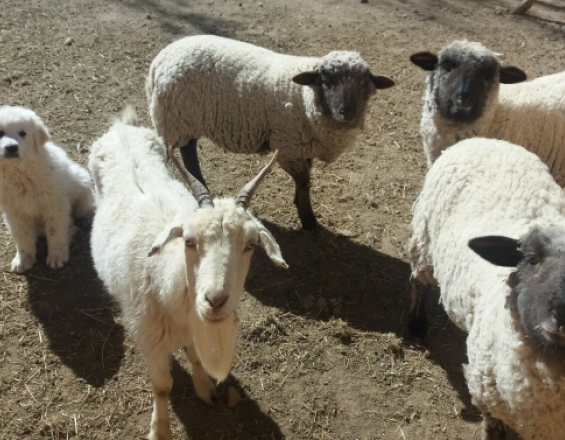
The expansion of livestock production over natural areas creates more opportunities for interaction between carnivores and livestock, increasing the chances of livestock predation by wild carnivores. This phenomena results in retaliatory killing of wild species, a great conservation challenge.
This conflict between producers and carnivores makes coexistence difficult. However, the use of livestock guarding dogs (LGD) have proven to be an effective non-lethal method of deterring carnivores from grazing areas and reducing predation on livestock. Northern Patagonia, Argentina, is home to the southernmost population of the endangered Andean cat (Leopardus jacobita), native to South America. About 50% of its records are of individuals hunted in retaliation. We implemented the use of livestock guarding dogs in areas where the species is present, resulting in a hopeful alternative for its conservation and for expanding livestock production in a way where coexistence is possible.
Context
Challenges addressed
Social
We expect to expand knowledge about LGD among producers, increasing confidence in their effectiveness, and to make the LGD more available by creating collaborations and training personnel from governmental agencies. We also expect to improve the perception of wild carnivores by producers.
Environmental
The main goal is to achieve positive coexistence between producers and wildlife, with a reduction in hunting, trapping or poisoning of wild carnivores in general, and Andean cats in particular. For the LGD technique to work there is a limit to herd size, so it reduces carrying capacity overload in native pastures, and also protects the soil from erosion.
Economic
The LGD breeding centre needs to be sustained until it can be replicated, also, we expect to obtain greater support from relevant governmental agencies.
We also improve the economic livelihood of livestock herders while benefiting wildlife conservation.
Location
Process
Summary of the process
Predation on livestock by wild carnivores generates significant economic and psychosocial costs to producers. In retaliation to eliminate the predators, rural dwellers use traps, poison and hunt with dogs, exerting a lethal control that is harmful to the target species, the biological community and a great threat to native species found at low densities, such as the Andean cat. In this scenario, livestock guardian dogs emerge as an opportunity to improve coexistence between producers and wild carnivores. Puppies of livestock guarding breeds need to be imprinted with livestock to generate family bonds and stimulate protective instincts. This requires a kennel that ensures animal welfare and facilitates the imprinting process between puppies and livestock. Also, it is of high importance and a substantial part of the project’s success, the work with the producers and that they are committed to the care and training of the guard puppy, as well as to the intention of generating a livestock farming that is friendly to the fauna and the environment. This requires people to be accompanied and trained. It is also essential to monitor the effectiveness of the presence of the LGD by assessing predation before and after the presence of the guard dog.
Building Blocks
Establishment of a livestock guardian dog breeding centre
The establishment of a breeding centre is a fundamental step in carrying out controlled breeding and imprinting of pups. Imprinting is a biological learning process, which is generated in a short period of time, where pups of most species can identify and learn behaviours of any other species. At the centre we provide the conditions for the pups to be in contact with goats and sheep from birth, and until they are four months old, creating a family bond that will make them protective with the livestock. This stage is critical and essential to achieve LGD that are effective in their function and strategic for carnivore conservation. During the imprinting process we take care of the feeding, health, welfare of the puppies and the livestock, while correcting undesirable behaviour in the puppy-livestock bond. After four months the puppies that are already vaccinated, dewormed and neutered, are handed over to the producers where they will finish their training and gradually start working with the livestock.
Enabling factors
To have at least one pair of dogs that belong to breeds created for livestock protection.
Physical space and budget for the period of imprinting the puppies, that includes support for a person responsible for the care, cleaning and feeding of puppies and livestock that is used for training.
Veterinary support for health controls and spaying/neutering.
To build collaborative partnerships between NGOs/government/businesses to reduce costs and make LGD affordable for producers.
Lesson learned
During the imprinting process, puppies should be constantly with livestock and contact with people should be minimal but friendly. The health and neutering of puppies is essential for animal welfare and to avoid the spread of diseases in the wild.
Raising, training and care of future protector puppies and breeding females
Social factors are important in conflicts between humans and predators. Predation has direct economic costs related to loss of income and food, and indirect economic costs such as time spent avoiding predation. There are also underestimated non-economic costs, related to the sense of uncertainty, insecurity and general disruption to livelihoods caused by the unexpected loss of livestock, which strongly influence human-carnivore interactions. Livestock keepers who choose to join this programme must be prepared to make cultural and behavioural changes, including changing their cultural relationship with predators and dogs. They must be committed to caring for and managing LGDs in a different way to how they normally interact with dogs. The herder must spend time with the dog in the first few months to ensure that it does not get lost, and must provide food and water on a daily basis.
Enabling factors
Commitment of the producers to work with, care for and complete the training of the LGD.
Logistical and technical capacity to visit and train the herders during the first months after receiving the puppy. This should be done until the puppy is at least one year old. This is essential to ensure that the puppy does not develop undesirable behaviours.
Lesson learned
Producers must be fully committed and convinced that they want to keep, train and care for a puppy and know what is required from them. LGD puppies must be accessible to low-income producers, who are most vulnerable to predation events.
Commitment of producers to try non-lethal alternatives to coexist with wild carnivores
Producers must also have to commit not to kill predators and to be part of a more environmentally friendly production. A final key aspect is that the conservationist using this technique will have to invest a considerable amount of time between training the dog, selecting puppy candidates, constant monitoring and much more. If the social factors mentioned before are not taken into account and these commitments are not met, the success of the project would not be possible.
Enabling factors
Commitment by participating herders not to kill wildcats.
Recording of depredation events before and after the LGD to provide evidence-based results.
Lesson learned
Selected herders should not use poison or traps in the livestock grazing area. It's important that they have a good relationship with their neighbours, otherwise the protection dogs will be at risk. Producers must be accompanied by technicians and be trained to successfully complete the protection dog training. On rare occasions when the puppy starts work it may bite or kill livestock, this behaviour must be corrected immediately using non-aggressive techniques. Producers must sign a pledge not to kill wildcats, mainly those at risk. It’s advisable to work with NGOs, producer associations, government and others to cover costs and ensure sustainability in time.
Impacts
Social
A Livestock Guarding Dogs (LGD) breeding facility was created in north Patagonia, with specific breeds developed for livestock protection. In this facility puppies are being trained and tested for their effectiveness.
20 LGD have been bred, trained and distributed. 95% of which are successfully protecting herds of sheep and goats.
LGD are monitored for proper training and to ensure animal welfare. Close communication with the herders is maintained during 8 to 12 months after delivery to assist during the training process.
100% of producers using LGD are satisfied with their performance.
A collaboration with the Southern Rural Society was developed that included training of an individual to start a new breeding centre. A puppy was delivered to start their breeding stock.
New producers are interested in participating in the project
Economic
90% reduction in annual depredation losses for producers using LGD that translates from an average of 68 livestock depredated per year to 7 livestock per year.
Producers with LGD went from losing USD 3,500 per year to just USD 450. This amount means a significant improvement in their household economy and quality of life.
Environmental
100% of producers have seen evidence of carnivore presence in the vicinity of the herd and pen, but there have not been any depredation events.
All producers with LGD committed not to kill wildcats, which benefits the scavenger assemblage.
Beneficiaries
Small goat and sheep herders that raise extensive livestock with an average herd size of 350 animals. Usually, they lease the land on which their families have lived for generations, even when some are native descendants.
Sustainable Development Goals
Story
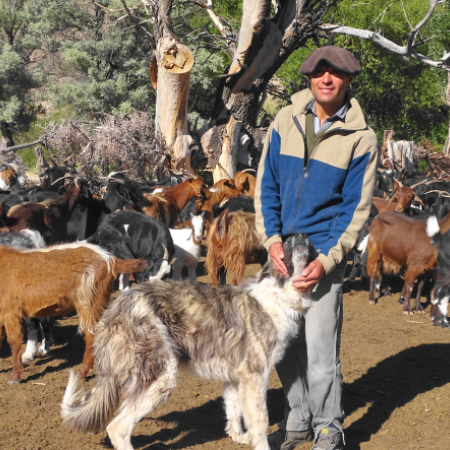
Attacks on livestock by wild carnivores, mainly pumas (Puma concolor) and foxes (Lycalopex culpaeus), can be truly devastating for some families. Pumas can kill up to 40 animals in a single event, generating a lot of hostility from producers and a strong persecution and harassment towards all carnivore species for the real or potential damage. The consequences are alarming for the ecosystems, because the methods to kill carnivores are not selective (poison, traps, hunting) and not only affect the target species but also scavengers such as the Andean condor (Vultur gryphus) and species that are not harmful but are at high risk of extinction, such as the Andean cat (Leopardus jacobita). Livestock guarding dogs (LGD) live with the herds 24 hours a day, deterring carnivores from approaching and preventing the death of livestock, as well as retaliatory killing of predators and scavengers. Producers with LGD no longer use poison or traps because their dogs can be affected. They do not go out hunting predators because predation losses have been reduced by 87% thanks to the presence of the LGD.
One farmer saw first-hand how his guard dog "Laika" chased off a puma. Like every morning in his summer pasture, Mr. Moyano sent the goats out to graze and of course Laika went out first, leading the way. Moyano prepared his mate, and followed the herd with his eyes, already far away on the slope of a hill. After a few minutes he watched the goats running to one side, while Laika barked and without second thoughts, got in the path of a puma that was chasing “her” goats. The puma ran away unharmed and Laika returned with her herd. Moyano tells that the puma was crouched on a rocky outcrop waiting for the goats to pass by, and it managed to kill one goat, but he is sure that the damage would have been a lot higher if it had not been for the heroic Laika. That day, Laika, not only saved several goats, she also saved the puma that would have surely been chased and killed. She also saved Andean cats, other carnivores, condors and other scavengers every day, because Moyano no longer uses traps or poison. He is proud of the work of his protective dog.


